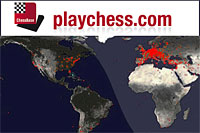
Igor Kovalenko wins Zalakaros Open
By Sagar Shah in Hungary
Our adventures in the European continent continue. After having a successful
tournament in Lille, Amruta (my wife) and I went to the land of Paprika,
Goulash, and medicinal and thermal waters – Hungary. Our flight landed
in Budapest, but the Zalakaros Open, which is the biggest open event to
be held in the country, was to take place in a small town, 200 kilometres
away from the capital city.
Zalakaros is a spa resort, located in western
Hungary.
It is the smallest town in the country with an area of only 17.17 sq.kms.
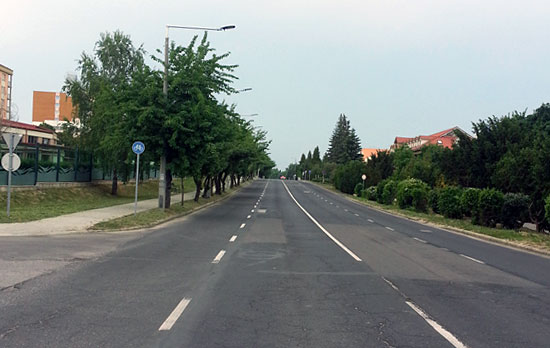
There is a highway which connects Budapest
to Zalakaros. The easiest way to reach the town
is by bus from Budapest-Nepliget station, and it takes around two and half
hours.

Zalakaros is so quiet and peaceful that you
can hardly spot any people,
and on almost any given occasion you can hear chirping of birds in the background
As you can understand from the above picture, the place where the tournament
was held was tranquil and harmonious, but the fight for the top spot in
the event was the complete opposite. It would be violent, bloody and brutal.
Going into the last round, the sixth seeded Igor Kovalenko (2650), who was
on 6.5/8, had a half-point lead over three other players – Ragger,
Adhiban and Boruchovsky. His game with Ragger was quite evenly balanced
until move 36, and then funny and unusual things started to happen.

Igor Kovalenko (left) against Markus Ragger.
You know that it was a fighting last round
when the top board battle goes on for 122 moves!

[Event "Zalakaros Open A"] [Site "Zalakaros"] [Date "2015.05.22"] [Round
"9.1"] [White "Kovalenko, Igor"] [Black "Ragger, Markus"] [Result "1/2-1/2"]
[ECO "A34"] [WhiteElo "2650"] [BlackElo "2668"] [Annotator "Sagar Shah"]
[SetUp "1"] [FEN "4r1k1/3R1p1p/6pP/1p3n2/3B1P2/1r2PKP1/8/4R3 b - - 0 36"]
[PlyCount "58"] [EventDate "2015.05.14"] [EventRounds "9"] [EventCountry
"HUN"] [Source "MSSZ"] [SourceDate "2015.05.21"] {The position is just
equal. The fun in the game starts from this point onwards. We are nearing
the 40th move, so mistakes are inevitable with less time on the clock.}
36... Rd3 {Black threatens to take twice on d4.} 37. Re2 $4 {With very
little time on the clock, Kovalenko makes a huge blunder. This might well
have sealed his fate with regards to winning the tournament.} (37. Rb1
{was better but how do you give up your all-important e3 pawn.} Nxd4+
38. Rxd4 Rexe3+ 39. Kf2 Rf3+ 40. Ke2 Rxd4 41. Kxf3 Rd5 42. Ra1 $11 {and
White will hold this endgame thanks to the h6 pawn.}) 37... b4 $2 (37...
Nxd4+ $1 { Transposing it into a pawn endgame would have been a trivial
win.} 38. Rxd4 Rxd4 39. exd4 Rxe2 40. Kxe2 Kf8 {The concept of outside
passed pawn is not something that needs to be taught to a 2650+ player!}
41. Kd3 Ke7 42. Kc3 Kd6 43. Kb4 Kc6 $1 (43... Kd5 $2 44. Kxb5 Kxd4 45.
Kc6 $11) 44. g4 f5 45. g5 Kd5 46. Kxb5 Kxd4 47. Kc6 Ke4 $19 {What a miss
by Ragger!}) 38. g4 Nxe3 39. f5 $5 { [%csl Rd4,Re3][%cal Re8e2,Rd3f3,Rd7d3]
A look at the board reveals what a crazy position of pins and discovered
attacks this is! The knight is pinned by the e2 rook but it can also launch
a discovered attack thanks to the d3 rook. On the other hand the d4 bishop
is also pinned! The threat now is to move the king to f4 which is promptly
stopped by Black.} g5 $1 40. Kf2 Nxg4+ 41. Ke1 { The rook on e2 cannot
be taken because after Kxe2 there will be an attack on the d3 rook and
a back rank mate. At the same time if the e8 rook moves then Rg2 is pretty
strong. That explains Black's next move.} Ne5 {[%csl Rd4,Re5] [%cal Rd3d7,Re2e8]
The game of pins continues!} 42. Kf1 Rd1+ 43. Kg2 Rd2 $1 { With this move
Black is able to extricate himself from the dangers and start pressing
for the full point.} 44. Rxd2 Nxd7 45. Rc2 (45. Bb2 Nc5 46. Kf3 $44 {
In spite of being two pawns down, White should draw this because of his
immense activity.}) 45... Kf8 46. Kf3 b3 $6 (46... Rb8 $17 {would have
been much better.}) 47. Bg7+ $1 Ke7 48. Re2+ $1 Kd8 49. Rb2 {Now the rook
cannot come to b8. Very smart play by Kovalenko.} g4+ 50. Kxg4 Re4+ 51.
Kf3 Rb4 { Black managed to save his crucial pawn by giving up the g-pawn.
He is still in the driver's seat.} 52. Bc3 Rb5 53. Kg4 f6 (53... Nc5 54.
Re2 Kd7 $1 $17 (54... Na4 55. Bf6+ Kc7 56. Re7+ Kc6 57. Rxf7 {is the typical
kind of counterplay that Black must prevent.})) 54. Kf4 Ne5 55. Ke4 Ke7
56. Rg2 {The rook becomes active and the bishop is ready to sacrifice
itself for the b-pawn.} Nf7 57. Kd3 Ne5+ (57... Rxf5 58. Kc4 Rh5 59. Re2+
Ne5+ 60. Kxb3 Ke6 61. Bd2 Kd5 {could have been a better try. The black
pieces are co-ordinating much better and the h6-pawn is weak.}) 58. Ke4
Kf8 (58... Nf7 {followed by Ng5 was much better.}) 59. Bb2 Nc4 60. Bxf6
{This is exactly what White was looking for.} b2 61. Bg7+ Ke8 62. Bxb2
Rxb2 63. Rg8+ Ke7 64. Rg7+ Kf6 65. Rxh7 {The final pawn is lost. Black
played on for another 57 moves before the game was drawn!} 1/2-1/2
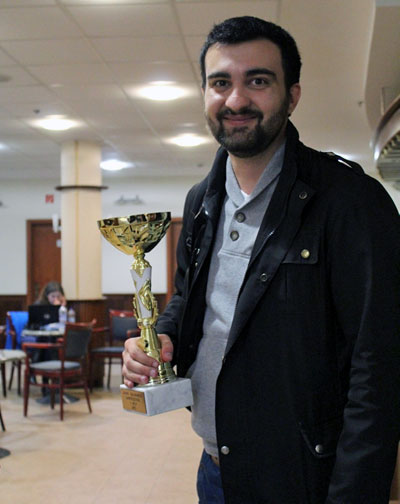
The champion of Zalakaros Open 2015: Igor Kovalenko
from Latvia went back home with
the winner’s trophy and a cash prize of 1,400,000 Hungarian Forints
(approximate US $4,960)
The 34th Zalakaros Chess Festival was held from the 14th to the 22nd of
May 2015 at the Hotel Karos Spa. It was a nine-round Swiss event with one
round being played every day. The time control was 40 moves in 90 minutes,
followed by 30 minutes for the rest of the game and a 30-second increment
from move one. There were two tournaments: the A group for those above 2300
Elo and a B group for those below 2400. The A group was an extremely strong
event with 29 GMs and 24 IMs in a field of 80 players. The Elo average of
the tournament was an impressive 2420. Vladimir Onischuk (2669) was the
top seed, with many strong players like Ragger, Berkes, Efimenko, Melkumyan,
Kovalenko, Adhiban and others fighting for the title.
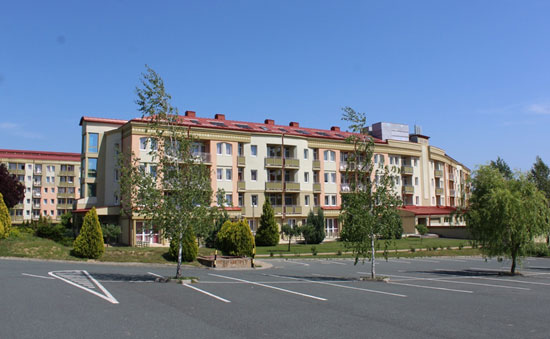
The playing venue, Hotel Karos Spa, is a four
star luxury property
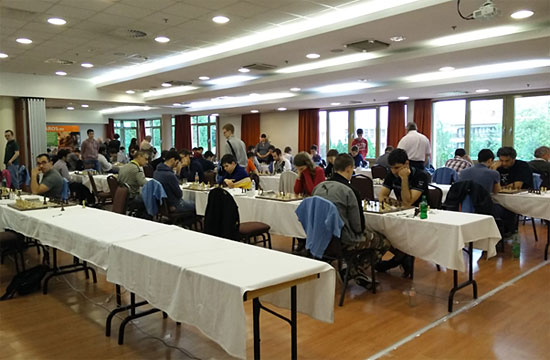
The tournament hall was bright and spacious.
The chess boards and pieces were
of excellent quality, with each and every game being transmitted live online
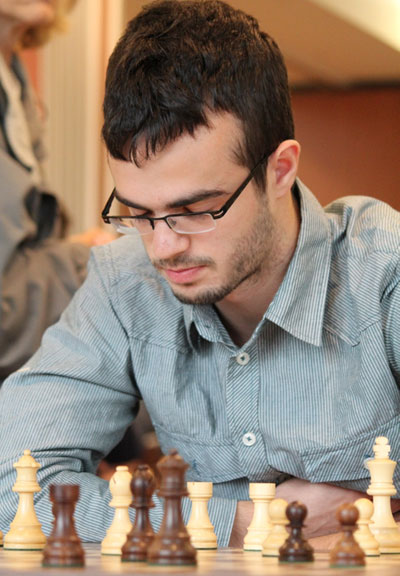
The early tournament leader was GM Avital Boruchovsky,
the young 18-year-old talent from Israel
He led the tournament until round seven with a score of 6.0/7, a half point
ahead of the rest. His scalps included GM Tamas Banusz, GM Gabor Papp and
GM Dennis Wagner. Avital’s biggest strength is his attacking chess.
He is also well prepared in the openings. And when then the two combine
you get a nearly flawless game.

[Event "Zalakaros Open A"] [Site "Zalakaros"] [Date "2015.05.17"] [Round
"4.5"] [White "Boruchovsky, Avital"] [Black "Banusz, Tamas"] [Result "1-0"]
[ECO "E11"] [WhiteElo "2517"] [BlackElo "2590"] [Annotator "Sagar Shah"]
[PlyCount "79"] [EventDate "2015.05.14"] [EventRounds "9"] [EventCountry
"HUN"] [Source "MSSZ"] [SourceDate "2015.05.21"] 1. d4 Nf6 2. c4 e6 3.
Nf3 Bb4+ 4. Nbd2 O-O 5. a3 Be7 6. e4 d5 7. e5 Nfd7 8. Bd3 c5 9. h4 {Of
course this move no longer comes as a surprise. We have many high quality
games in this line starting from 2011. White's caveman approach is not
so easy met. He currently threatens to take on h7 followed by Ng5 and
Qh5 and game over!} g6 (9... h6 10. Bb1 {followed by Qc2 is also not without
danger for Black.}) 10. h5 cxd4 11. Nb3 $5 {The latest tweak in this line
introduced by David Navara in his game against Timman from Wijk Aan Zee
2015. That ended in a 19-move win for the Czech player. The logic of this
move is very simple: the d3 bishop is the most important piece on the
board for White and Black always wants to get rid of it with Nc5, which
will move it off the important diagonal or allow the blocking move d3.
But with this move White stops Nc5 and intends to follow up with Qc2 and
pressure on the g6 point.} Nc6 {A logical developing move putting pressure
on the e5 pawn.} (11... Na6 {I was wondering whether we could get our
knight on c5 in any case. But it turns out to be a huge mistake due to}
12. cxd5 $1 exd5 13. e6 $1 $18 {and the black position is ripped to shreds.})
(11... dxc4 12. Bxc4 b5 $2 13. Bd3 Bb7 14. Qd2 $1 $40 {was Navara-Timman,
where the Dutch player was completely crushed.}) 12. Bf4 { Defending the
e5 pawn.} dxc4 13. Bxc4 g5 {Banusz is well prepared in the line and makes
all the computer moves.} 14. Bg3 g4 15. Nfxd4 Ndxe5 {So Black has gained
the important e5 pawn, but his king is weak and he must remain extremely
careful.} 16. O-O $5 Bf6 (16... Bh4 $5 $13 {looks like a possible improvement.})
(16... Nxc4 17. Qxg4+ Kh8 18. Nxc6 bxc6 19. Qxc4 $16 {is just better for
White.}) 17. Re1 {White already threatens taking on c6 followed by taking
on g4.} Nxc4 (17... Kh8 18. Nxc6 Qxd1 (18... Nxc6 19. Qxg4 $16) 19. Bxe5
$3 $18 {is the neat tactical point.}) 18. Qxg4+ Kh8 19. Nxc6 bxc6 20.
Rad1 $1 { A very strong intermezzo, getting all the pieces into the game.}
Qb6 21. Qxc4 $16 {White has a clear advantage.} Qb5 22. Qf4 {Of course
keeping the queens on.} Qg5 23. Qf3 e5 24. Qxf6+ {Transposing into a winning
endgame with an extra pawn.} Qxf6 25. Bxe5 Qxe5 26. Rxe5 Rb8 27. Nc5 Rxb2
28. h6 Be6 29. Rg5 Re2 30. Rd6 Rc8 31. f3 Ba2 32. Rd7 a5 33. Ra7 Rd8 34.
Rc7 Bd5 35. Nb7 Rde8 36. Nd6 Rf8 37. Rg7 Re1+ 38. Kf2 Rh1 39. Nxf7+ Bxf7
40. Rgxf7 {Avital's opening preparation was excellent, his feel for attack
and initiative was great and his endgame technique was nearly flawless.
That's why he is a very strong player.} 1-0
It seemed as if Avital would run away with the tournament, but the man
from Latvia had some other plans! Igor Kovalenko started the tournament
with a loss. But he fought back, scoring 6.5 points in the next seven rounds
to take the sole lead. The things which are truly amazing about Kovalenko
are his fighting spirit and recklessly bold approach. He doesn’t really
care much about openings, the objective evaluation of the line or the latest
theoretical status. These are important points for theoretical experts,
not a practical player like Igor. His main strength is connected with his
dynamic play and taking rational decisions in complex positions.
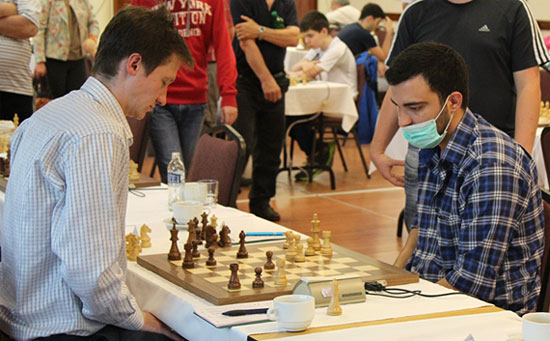
Even some health issues didn’t stop Igor
from scoring an impressive win against Efimenko
You must take a look at Kovalenko’s games from this tournament. He
was dead lost in some of them, but fought back, most importantly in the
last round against Ragger. His game against GM Antal Gergely was the perfect
example of how Igor plays weird material imbalances like a rook + knight
+ bishop against queen + three pawns in a superb practical manner. When
he was asked for his best game in the tournament, he mentioned the crucial
eighth round encounter against Avital Boruchovksy, where he was able to
wrest the lead from his opponent.

[Event "Zalakaros Open A"] [Site "Zalakaros"] [Date "2015.05.21"] [Round
"8.1"] [White "Boruchovsky, Avital"] [Black "Kovalenko, Igor"] [Result
"0-1"] [ECO "E08"] [WhiteElo "2517"] [BlackElo "2650"] [Annotator "Sagar
Shah"] [PlyCount "86"] [EventDate "2015.05.14"] [EventRounds "9"] [EventCountry
"HUN"] [Source "MSSZ"] [SourceDate "2015.05.21"] {This was the crucial
eighth round encounter on the top board. Boruchovsky was going strong
and leading the tournament by half a point. It was now in the hands of
Kovalenko to stop him.} 1. Nf3 d5 2. c4 e6 3. g3 Nf6 4. Bg2 Be7 5. d4
{This move order is usually preferred by white players in order to prevent
the Bb4 followed by Be7 ideas. Now that the bishop is on c1, it can be
used in a much better manner on the b2 square, and also the d2 square
can be utilized by the b1 knight.} O-O 6. O-O c6 7. b3 b6 8. Qc2 Nbd7
{Black develops his knight before the bishop to keep open the option of
developing Ba6 or Bb7.} 9. Nc3 { Now that the knight has developed itself
on c3, the c4 pawn is relatively undefended and that explains Black's
next move.} Ba6 10. Bb2 $5 {A bold decision to sacrifice the c4 pawn.}
Rc8 (10... dxc4 {was a valid option for Black. A forcing line from this
point onwards could go something like this:} 11. Ne5 Nxe5 12. dxe5 Nd5
13. bxc4 Bxc4 14. Ne4 b5 15. Rfd1 $13 {and White's compensation is beyond
doubt, with his two strong bishops. But Black with an extra pawn and central
control is not doing so badly. In short it is a big fighting game ahead.})
11. e4 dxc4 12. Rfd1 Qc7 (12... cxb3 13. axb3 $14 { [%cal Ga1a7] Opening
up the a-file would not be a good idea for Black.}) 13. e5 {A risky move.
But the danger exists for both sides now. White gets good attacking chances.}
(13. Ne2 {was more prudent.} b5 (13... cxb3 14. axb3 $44 { [%cal Ga1a7]})
14. bxc4 bxc4 $11 {Sooner or later the c4 pawn will fall, but by that
time Black would be able engineer the c5 break and equalise the game.})
13... Nd5 14. bxc4 (14. Ne4 {would be met with the strong central break}
c5 $1 15. bxc4 cxd4 $15) 14... Bxc4 15. Ne4 {This is a position which
computers assess clearly in Black's favour, thanks to the extra pawn.
But over the board things are entirely different. When your king is under
attack the -/+ 0.74 evaluation is not of huge help!} b5 16. Neg5 g6 17.
Qe4 {White has the intention of playing Qh4.} Kg7 (17... c5 {looks like
the natural reaction. Let's continue the white attack.} 18. Qh4 h5 19.
g4 Kg7 $1 {A not so difficult, yet very important idea to foresee.} 20.
gxh5 Rh8 $1 21. Qg3 Rxh5 $17 {And Black has a super solid king position.
At the same time the white center is falling apart.}) 18. h4 {White introduces
a new character to keep the attack alive.} (18. Qh4 h6 $19 {is completely
winning for Black.}) 18... N7b6 19. h5 Na4 {The black knights start to
cause mayhem in White's position.} 20. Bc1 Nac3 {A deadly knight fork
and it seems as if the game is over.} 21. Qh4 {There are some threats
on the kingside and Black has to be careful not to blunder.} Ne2+ (21...
h6 {is a nice solution. The point being after} 22. hxg6 {Black has the
ultra strong} Rh8 $1 $19 {and White is losing just about everything.})
22. Kh2 Nxc1 {A very human way to play the position.} 23. h6+ (23. Raxc1
h6 24. hxg6 Qd8 $19) 23... Kg8 24. Rdxc1 {The chances of a kingside attack
have almost vanished for White and he stands a pawn down with a completely
lost position.} Bd3 25. Bf1 Bxf1 26. Rxf1 c5 $1 $19 {The final nail in
the coffin. After this break Black is no longer passive, and his extra
pawn starts marching down the board.} 27. Qg4 c4 28. Ne4 c3 29. Rfc1 a5
30. Nfd2 a4 31. a3 Qb6 32. Nf1 Kh8 33. Qd1 Rc4 34. Ne3 Rxd4 35. Qf3 Qb8
36. Nxd5 Rxd5 37. Nd6 f6 38. Rxc3 fxe5 39. Nf7+ Kg8 40. Qg4 Qb6 41. Ng5
Bxg5 42. Qxg5 Qxf2+ 43. Kh3 e4 {A nearly flawless game from Kovalenko,
and he judged it to be one of his best from the tournament. It was this
game that gave him the sole lead going into the last round.} 0-1

The secret to winning a strong open: always
have a positive attitude
Avital Boruchovsky drew his last round game against B. Adhiban to finish
second. In the third spot was the strong Austrian GM Markus Ragger.

Four hours into the last round, Markus Ragger had the best chance to win
the tournament. But in the end he had to settle for the third place. Ragger
was maybe the most consistent player in the tournament. He remained unbeaten
and performed at an excellent Elo of 2734.

India’s B. Adhiban finished fourth with
6.5/9
Top final rankings (after nine rounds)

GM Adam Horvath finished fifth, but he got
the higher prize for
the best Hungarian player: 600,000 Forints (approximately US $2125 )

The second best Hungarian player, GM Gabor
Papp, who started strongly with 4.0/5, lost two games
to Boruchovsky and Adhiban, but made it up with a last round win against
GM Zoltan Medvegy
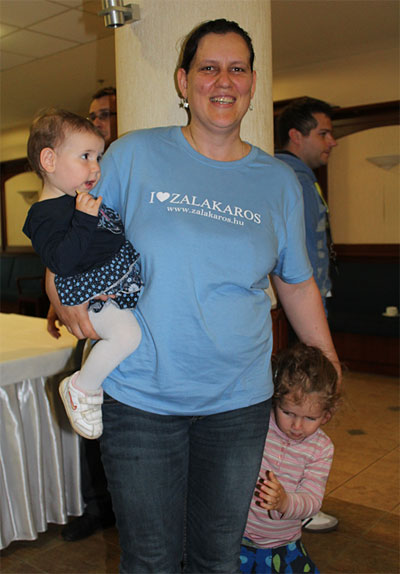
IM Szidonia Vajda (2333) was the best woman
player at the event
A few words must be said about this 35-year-old lady. Szidonia was surely
the most deserving woman player in the event. She beat GM Danny Raznikov
(2494), IM Peter Schreiner (2449) and GM Tamas Banusz (2589). She resumed
playing active chess only a year ago – prior to that, she had taken
a break from chess in order to focus on her family. Since last year or so
she has been training regularly with GM Joszef Horvath and her results in
this event show that their work is not in vain. Vajda came to the tournament
with her two little kids (as can be seen in the above picture) and one can
only imagine how difficult it must have been for her to perform the double
role of mother and chess player. Hats off to this strong-willed and determined
chess player.

FM Balazs Csonka (2433) scored 5.0/9 and won
the prize for the best Hungarian junior

IM Bogdan-Daniel Deac scored a GM norm
Bogdan-Daniel, just 14 years of age, is currently the most talented player
in Romania. He scored 5.5/9 in Zalakaros, gaining 23 Elo points, with a
performance of 2621. Particularly impressive was the opposition against
whom he “held fort” (as cricketers would say). To remain unbeaten
against the likes of Ruck, Wagner, Prohaszka, Adhiban and Donchenko is not
an easy task. We will hear much more in future about this young lad.
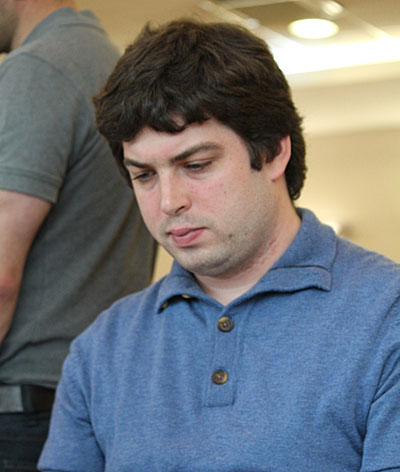
IM Robert Kreisl played a great tournament,
beating Onischuk, Donchenko and Ruck, but was unlucky
to miss out on his GM norm when he couldn’t draw his last round game
against GM Peter Prohaszka

GM Zahar Efimenko had a forgettable event as
he scored just 5.0/9 and finished 22nd

Playing against your better half is not an
easy task as the author
of these lines discovered in the sixth round of the tournament
It was the first time after marriage that I faced Amruta. Imagine travelling
together for the last 40 days, sharing preparation, notes, advising each
other – and now all of a sudden you have to play against that same
person! We both decided to play a full-fledged game of chess, not agreeing
to a draw, as many couples would have done. Our idea was to show that it
is possible for players to have the best of relations off the board and
be mortal enemies on it. Of course this was easier said than done. I think,
finishing off a won game against your spouse, best friend or sparring partner
is the most difficult thing and requires you to have great nerves. Maybe
that’s something both of us must learn in the future. Even though
I didn’t gain much by winning against my wife, we both came out as
psychologically stronger individuals from this game.

Super-strong siblings: Csaba and Jozsef Horvath
According to my research, the strongest siblings (rating-wise) in the world
are Andrey and Sergei Zhigalko. I met Andrey in the Lucopen in Lille but
Sergei wasn’t playing. The second strongest siblings are the Vovk
brothers. Once again I met Andrey in Metz but Yuri wasn’t playing.
In Zalakaros, I met the third strongest siblings in the world – and
both of them were playing! In the picture above, you can see Csaba Horvath
who is the younger one on the left and Jozsef Horvath on the right.
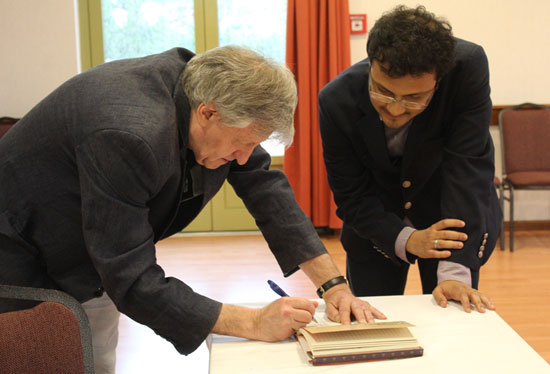
Interacting with a true legend of the game:
Oleg Romanishin
Ukrainian grandmaster Oleg Romanishin needs no introduction. He is 63 years
old and one of the living legends of the game. Back in the 70s and 80s he
crossed swords with the likes of Tal, Petrosian, Spassky and Smyslov, and
scored victories against each of them. He continues to play at a high level
and in the 2000s has beaten super-elite players like Adams and Ivanchuk.
In my autograph book of famous players I always ask them to quote one of
their own games that they are especially proud of, Romanishin mentioned
three exceptional battles. Watch out for an article on that soon.
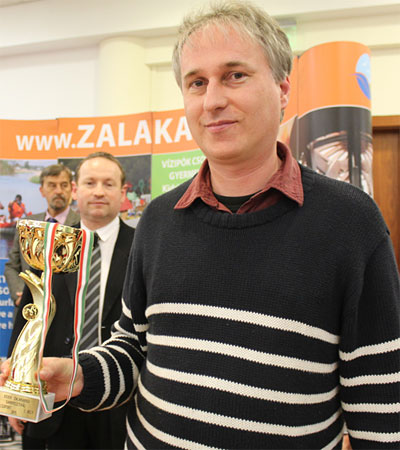
IM Imre Fancsy won the B category tournament
with 7.5/9.
To final rankings or the Chess Festival B U 2400 (after nine rounds)
| Rk. |
SNo |
Ti. |
Name |
FED |
Rtg |
Pts. |
TB1 |
TB2 |
TB3 |
| 1 |
2 |
IM |
Fancsy Imre |
HUN |
2389 |
7.5 |
56.0 |
41.5 |
2502 |
| 2 |
1 |
IM |
Almasi Istvan |
HUN |
2393 |
7.5 |
53.5 |
39.0 |
2501 |
| 3 |
4 |
FM |
Ruck Tamas |
HUN |
2344 |
7.0 |
53.5 |
39.0 |
2429 |
| 4 |
6 |
IM |
Ianov Viktor |
UKR |
2305 |
7.0 |
49.5 |
34.5 |
2350 |
| 5 |
7 |
IM |
Kernazhitsky Leonid |
UKR |
2278 |
6.5 |
55.0 |
35.0 |
2327 |
| 6 |
9 |
IM |
Meszaros Andras |
HUN |
2267 |
6.5 |
52.0 |
34.5 |
2317 |
| 7 |
15 |
|
Zentai Peter |
HUN |
2225 |
6.5 |
52.0 |
34.0 |
2305 |
| 8 |
18 |
FM |
Jamrich Gyorgy |
HUN |
2203 |
6.5 |
49.0 |
34.5 |
2288 |
| 9 |
14 |
FM |
Zsirai Peter |
HUN |
2237 |
6.5 |
49.0 |
33.5 |
2358 |
| 10 |
13 |
IM |
Medancic Rikard |
CRO |
2241 |
6.5 |
49.0 |
33.5 |
2264 |
| 11 |
5 |
IM |
Csonka Attila Istvan |
HUN |
2326 |
6.5 |
48.5 |
32.5 |
2309 |
| 12 |
16 |
|
Dobai Szabolcs |
HUN |
2213 |
6.5 |
39.5 |
25.0 |
2102 |
| 13 |
11 |
FM |
Veleski Robert |
MKD |
2255 |
6.0 |
52.0 |
35.0 |
2272 |
| 14 |
10 |
FM |
Pasztor Ferenc |
HUN |
2259 |
6.0 |
51.5 |
34.5 |
2285 |
| 15 |
17 |
FM |
Krstulovic Alex |
HUN |
2210 |
6.0 |
49.0 |
33.0 |
2261 |
| 16 |
3 |
IM |
Kiss Attila |
HUN |
2385 |
6.0 |
49.0 |
32.0 |
2266 |
| 17 |
66 |
|
Chu Ruotong |
CHN |
1884 |
6.0 |
47.0 |
26.5 |
2199 |
| 18 |
19 |
|
Horak Jiri |
CZE |
2190 |
6.0 |
46.0 |
31.0 |
2132 |
| 19 |
28 |
|
Pribelszky Bence |
HUN |
2143 |
6.0 |
45.0 |
30.5 |
2173 |
| 20 |
8 |
FM |
Kovac Boris |
SLO |
2276 |
6.0 |
43.5 |
28.0 |
2148 |

One of Hungary’s strongest players, Ferenc
Berkes (left, with the famous writer
and author Tibor Karolyi) finished eighth in the tournament

Zoltan Medvegy and Csaba Balogh (who was not
playing at the event),
a member of the Hungarian National team.
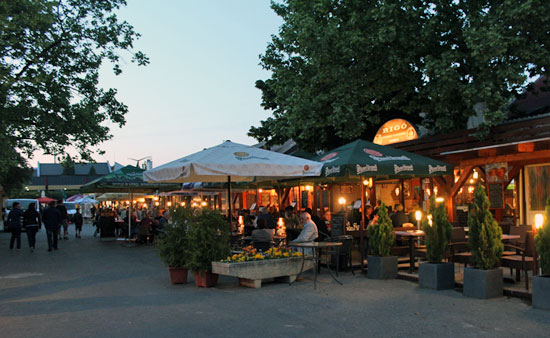
Beautiful cafes and restaurants adorn the streets
of Zalakaros
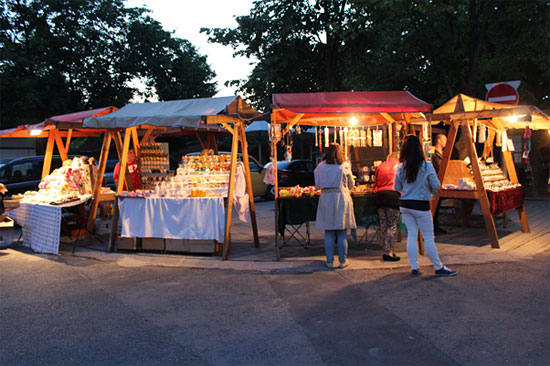
The weekend market has some very nice and original
stuff on sale …

Naturally Amruta was hooked

Tamas Horvath, the main organizer, who makes this beautiful tournament
happen
I had a wonderful time in Zalakaros. If you are looking to combine a place
where you can enjoy clean, pollution-free air with beautiful landscapes,
greenery and thermal body massage along with a super-strong chess tournament,
Zalakaros is the place to be.
Pictures by Amruta Mokal
















































